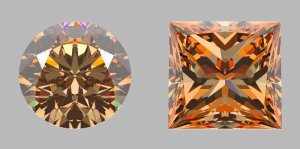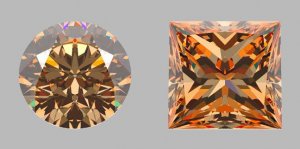- Joined
- Aug 15, 2000
- Messages
- 19,104
Dear Carrot,
You seemed to have raised the ire of some folk
That is not a bad thing if it helps educate people.
A couple of observations after skimming this last lot of posts.
The picture here shows the modeled variation in color of diamond that can result in different types of cut. In the face up position there is clearly a difference between the color we see in a round brilliant and a princess. It is no accident that most fancy yellow diamonds are made darker, and hence more valuable, by not making them round brilliants. So when folk say "my diamond looks whiter because it is a well cut round brilliant" they are reporting a well known and scientifically evident bit of physics. if you or oters want to learn more about this then this link is where we are discussing the lighting types that GIA used in its Cut study and its new grading system. Yuri, Sergey and Marty are scientists who know what they are talking about. Note that fire is not greatly impacted by the absorption of specific blue wave lengths - there are technical reasons for this, but one way to experiment yourself is to look for green fire in any diamond - it is rare. Yellow is the next rarest; this has nothing to do with nitrogen type blue absorption.
https://www.pricescope.com/community/threads/why-did-gia-included-steep-deep-diamonds-in-excellent.32135/page-4
Other comments people made - like is D really rare. Yes it is - do a search for G, or H, or I and see how many round brilliants are listed on Pricescope, then try D and E.
I regulalry test people buying diamonds and very few can see D - G, and about 50% can pick D from H in shaded daylight in well cut rounds. Princess and other cuts are a different story - one reason I do not like radiants in colourless stones is they show color more.
No one can pick the brilliance and fire difference between D and G stones.

You seemed to have raised the ire of some folk
That is not a bad thing if it helps educate people.
A couple of observations after skimming this last lot of posts.
The picture here shows the modeled variation in color of diamond that can result in different types of cut. In the face up position there is clearly a difference between the color we see in a round brilliant and a princess. It is no accident that most fancy yellow diamonds are made darker, and hence more valuable, by not making them round brilliants. So when folk say "my diamond looks whiter because it is a well cut round brilliant" they are reporting a well known and scientifically evident bit of physics. if you or oters want to learn more about this then this link is where we are discussing the lighting types that GIA used in its Cut study and its new grading system. Yuri, Sergey and Marty are scientists who know what they are talking about. Note that fire is not greatly impacted by the absorption of specific blue wave lengths - there are technical reasons for this, but one way to experiment yourself is to look for green fire in any diamond - it is rare. Yellow is the next rarest; this has nothing to do with nitrogen type blue absorption.
https://www.pricescope.com/community/threads/why-did-gia-included-steep-deep-diamonds-in-excellent.32135/page-4
Other comments people made - like is D really rare. Yes it is - do a search for G, or H, or I and see how many round brilliants are listed on Pricescope, then try D and E.
I regulalry test people buying diamonds and very few can see D - G, and about 50% can pick D from H in shaded daylight in well cut rounds. Princess and other cuts are a different story - one reason I do not like radiants in colourless stones is they show color more.
No one can pick the brilliance and fire difference between D and G stones.










300x240.png)